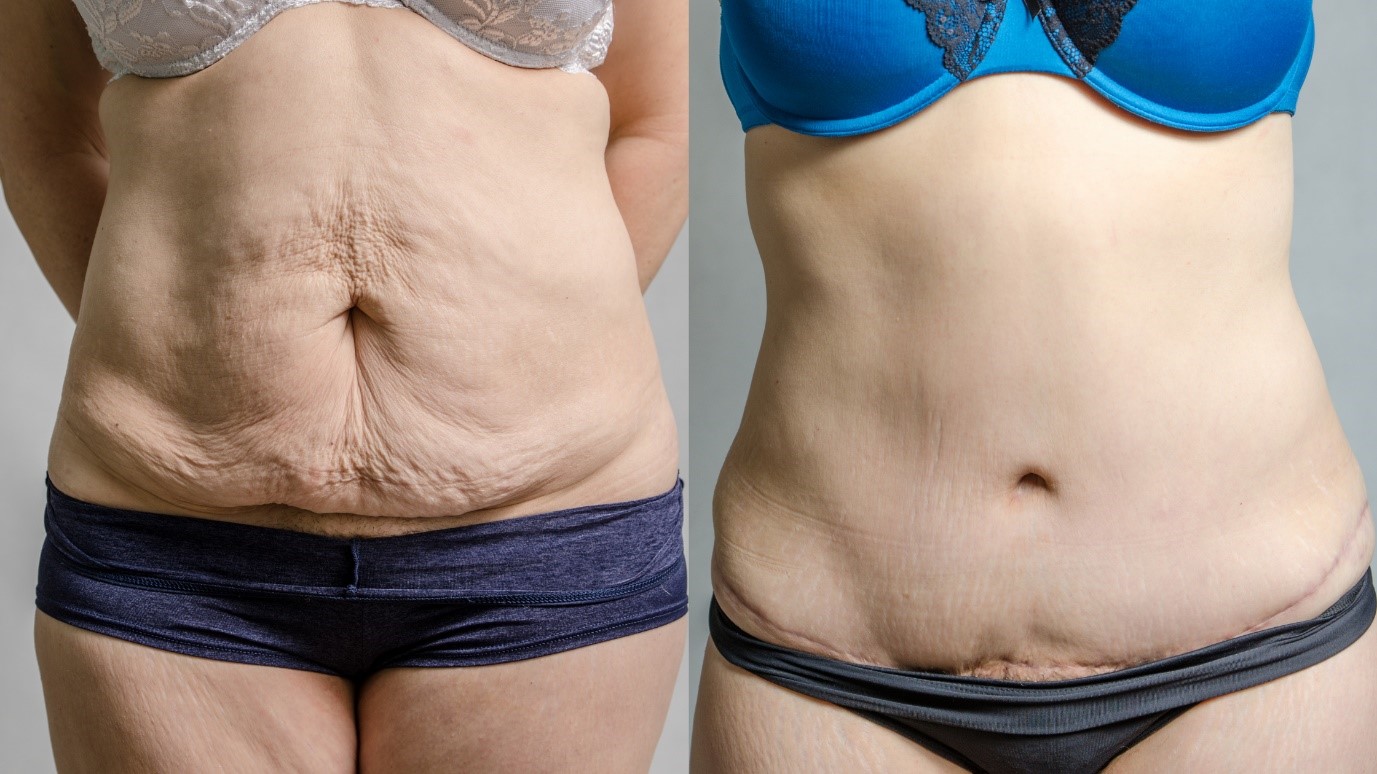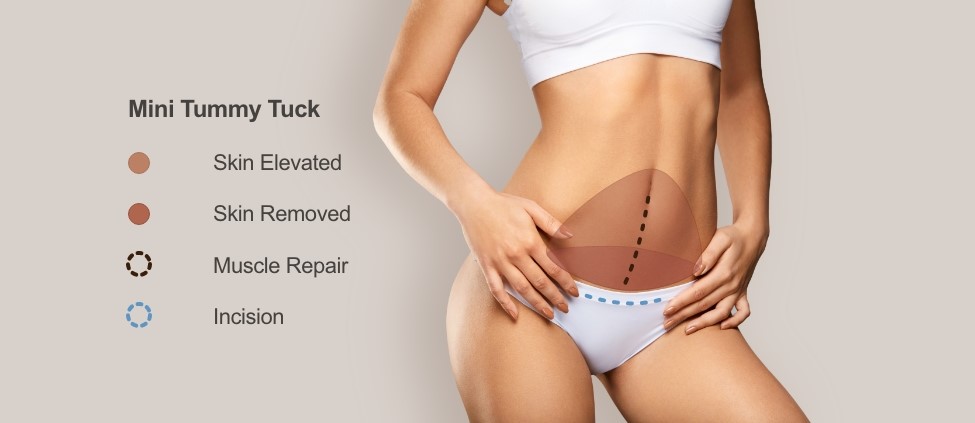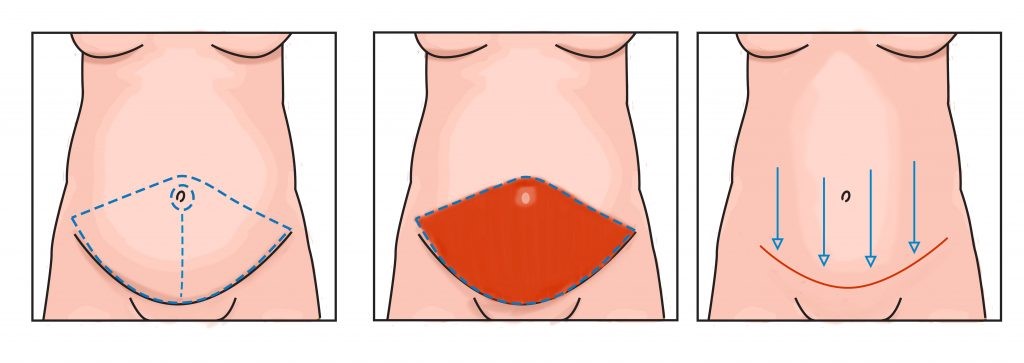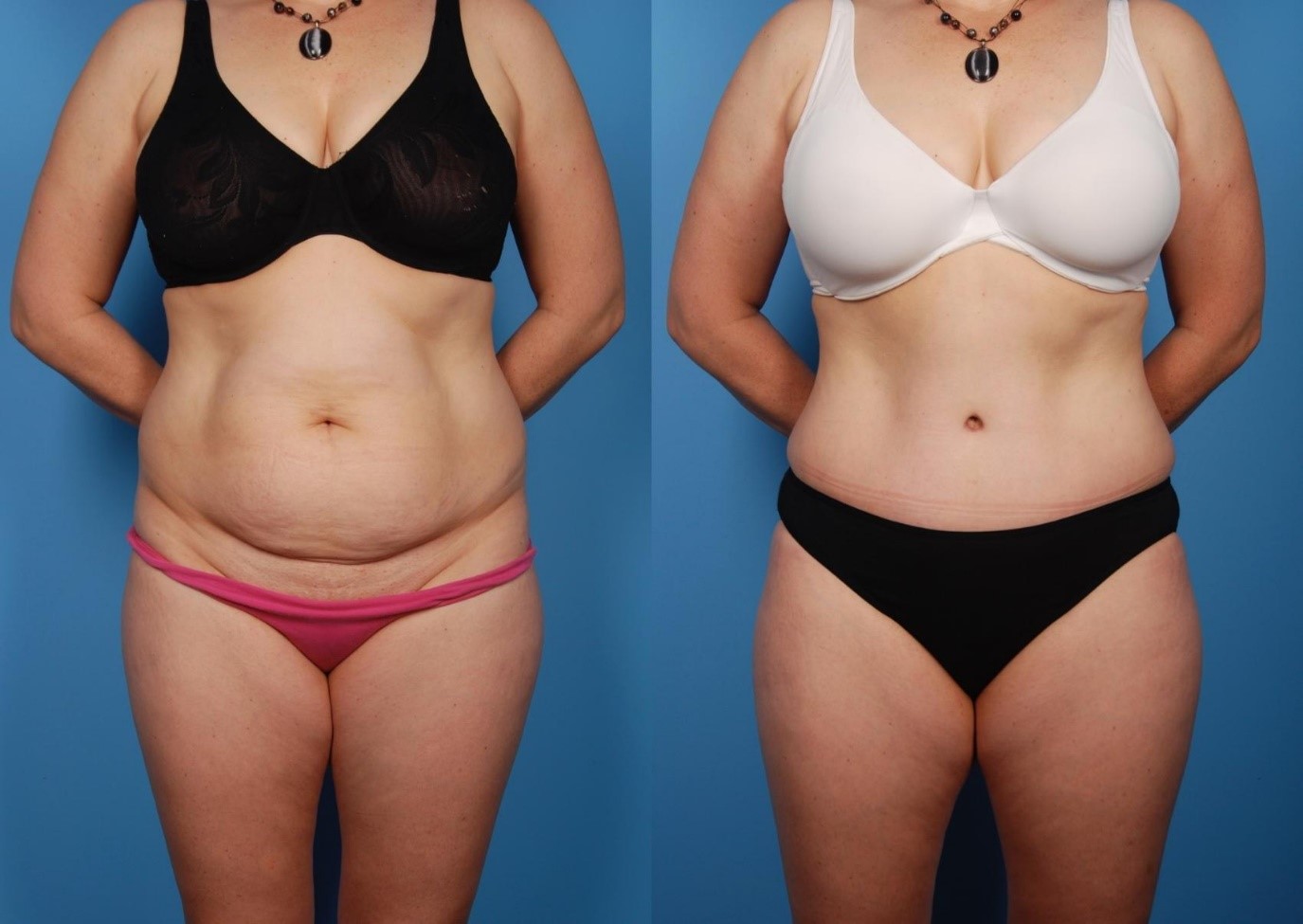What is a tummy tuck?
A tummy tuck — also known as abdominoplasty — is a cosmetic surgical procedure to improve the shape and appearance of the abdomen.
During a tummy tuck, excess skin and fat are removed from the abdomen. Connective tissue in the abdomen (fascia) usually is tightened with sutures as well. The remaining skin is then repositioned to create a more toned look.
You might choose to have a tummy tuck if you have excess fat or skin around the area of your bellybutton or a weak lower abdominal wall. A tummy tuck can also boost your body image.
Why it’s done
There are a number of reasons you might have excess fat, poor elasticity of the skin or weakened connective tissue in your abdomen. These include:
- Significant changes in weight
- Pregnancy
- Abdominal surgery, such as a C-section
- Aging
- Your natural body type
A tummy tuck can remove loose, excess skin and fat, and tighten weak fascia. A tummy tuck may also remove stretch marks and excess skin in the lower abdomen below the bellybutton. However, a tummy tuck won’t correct stretch marks outside of this area.
If you’ve previously had a C-section, your plastic surgeon might be able to incorporate your existing C-section scar into your tummy tuck scar.
A tummy tuck can also be done in combination with other body contouring cosmetic procedures, such as breast surgery. If you’ve had fat removed from your abdomen (liposuction), you may decide to have a tummy tuck because liposuction removes tissue just under the skin and fat but not any excess skin.
A tummy tuck isn’t for everyone. Your doctor might caution against a tummy tuck if you:
- Plan to lose a significant amount of weight
- Might consider pregnancy in the future
- Have a severe chronic condition, such as heart disease or diabetes
- Have a body mass index that’s greater than 30
- Smoke
- Have had a previous abdominal surgery that caused significant scar tissue
BEST PLASTIC SURGEONS PERFORMING ABDOMINOPLASTY IN IRAN
Going for plastic surgery like abdominoplasty is a difficult decision, so is choosing the best plastic surgeon for your procedure. Whether you’re considering Iran for the reasonable prices or high-quality medical services, you would definitely want to have surgery under the hands of a skilled Iranian surgeon.
With many years of training and practicing in the field of plastic surgery, Iranian surgeons have got the necessary knowledge and experience to perform the most effective tummy tuck surgeries.
Most Iranian surgeons, if not all, have earned their fellowships and certifications in plastic surgery from top medical universities in Iran and around the globe. Therefore, you can rest assured that you will have a safe treatment for your protruded abdomen with the least possibility of any upcoming complications.
COST OF TUMMY TUCK IN IRAN
As the cost of abdominoplasty in many countries is going through the roof, more patients are looking elsewhere for this procedure. In this situation, a country like Iran takes the lead, showing up as a cheaper alternative.
An average tummy tuck surgery costs between $2,500 and $4,500 in Iran, depending on the experience of the surgeon, hospital, etc. This price includes almost everything you may need when traveling to the country such as accommodation, transfer, and treatment.
(Please note that this is simply a price range for tummy tuck in Iran. Our prices are usually somewhere near or above the average of this range given our quality of services and the expertise of our surgeons.)
This surgery, however, costs from $3,000 to $30,000 in the US, with most patients paying around $15,000 for the surgery. It also prices from $4,000 to $7,000 in a European country like the UK, while it costs around $5,000 in Turkey and $3,000 in India.
Who Are the Best Candidates For a Tummy Tuck?
A tummy tuck is suitable for men and women who are in good health.Women who have had several pregnancies may find the procedure useful for tightening their abdominal muscles and reducing skin. A tummy tuck is also an option for men or women who were once obese and still have excess fat deposits or loose skin around the belly.
Who Should Not Consider a Tummy Tuck?
If you’re a woman who plans to get pregnant, then you may want to postpone a tummy tuck until you’re done having children. During surgery, your vertical muscles are tightened, and future pregnancies can separate those muscles.
Are you planning to lose a lot of weight? Then a tummy tuck also is not for you. A tummy tuck should be a last resort after you’ve tried everything else. It should not be used as an alternative to weight loss.
How to Prepare for Tummy Tuck Surgery
The first step is to choose a surgeon and see them for a consultation. At that meeting, you’ll talk about your goals and the following options:
- Complete abdominoplasty. The surgeon will cut your abdomen from hipbone to hipbone and then contour the skin, tissue, and muscle as needed. The surgery will involve moving your belly button, and you may need drainage tubes under your skin for a few days.
- Partial or mini abdominoplasty. Mini-abdominoplasties are often done on people whose fat deposits are located below the navel. During this procedure, the surgeon most likely will not move your belly button, and the procedure may only take up to two hours, depending on your case.
If you smoke, your doctor will ask that you quit smoking from at least two weeks before the surgery until two weeks after the surgery. It is not enough to just cut down on smoking. You must stop completely since smoking makes complications more likely and slows healing.
Don’t try a drastic diet before the surgery. Eat well-balanced, complete meals. A healthy diet may help you heal better.
Tell your doctor about everything you take, including prescription drugs, herbal medicines, and other supplements. Your surgeon may instruct you to stop taking certain medications for a time before and after the surgery.
Before getting the surgery, get your home ready. You’ll need:
- Ice packs
- Loose, comfortable clothing that can be put on and off very easily
- Petroleum jelly
- Hand-held shower head and bathroom chair
You’ll also need someone to drive you home after the tummy tuck. If you live alone, you’ll want someone to stay with you for at least the first night. Make a plan for that.
A tummy tuck is done in a hospital or an outpatient surgical facility. During a tummy tuck, you’ll be under general anesthesia — which makes you completely unconscious and unable to feel pain. In some cases, you might be given a pain-relieving medication and be moderately sedated (partially asleep).
Before the procedure
There are a number of different procedures for a tummy tuck, depending on your goals and the extent of change you would like to see. During the typical tummy tuck, your plastic surgeon makes incisions to remove most of the skin and fat between your bellybutton and pubic hair in a horizontal oval or elliptical shape. Connective tissue (fascia) that lies over the abdominal muscles is then tightened with permanent sutures.
The amount of excess skin removed and the type of procedure you have will determine the shape and length of the incision. The incision above the pubic hair will be stitched together and will leave a scar that falls along the natural crease within the bikini line.
Your plastic surgeon will also reposition the skin around your bellybutton. Your bellybutton will be brought out through a small incision and sutured in its normal position.
During the procedure you might be given an antibiotic to prevent infection.
The procedure typically takes about two to three hours.
After the procedure
After a tummy tuck, your abdominal incision and bellybutton will likely be covered with surgical dressing. Small tubes might be placed along the incision site to drain any excess blood or fluid.
Members of your health care team will help you walk as early as the first day after a tummy tuck to help prevent the formation of blood clots.
You’ll likely be given pain medication. It’s normal to have swelling in the surgical area.
Drains might be left in place for several days after surgery. Your doctor or another member of your health care team will show you how to empty and care for your drains. You might need to continue taking an antibiotic as long as the drains are in place.
Your surgeon might also prescribe a blood-thinning medication for a short time after your tummy tuck.
You’ll wear a supportive abdominal garment (abdominal binder) for about six weeks after your tummy tuck. This helps prevent fluid buildup and provides abdominal support while you heal. Your doctor will explain how to care for your scar.
For the first six weeks after a tummy tuck, you’ll need to be careful when moving around. You’ll also need to avoid positions that strain your incision line — such as quickly bending at the waist — to prevent the reopening of the wound.
You’ll need to schedule regular follow-up visits. Ask your doctor how often you need to be seen.
Results
By removing excess skin and fat and strengthening your abdominal wall, a tummy tuck can give your abdomen a more toned and slimmer appearance.Tummy tuck results are usually long lasting if you maintain a stable weight.
Risks
A tummy tuck poses various risks, including:
- Fluid accumulation beneath the skin (seroma). Drainage tubes left in place after surgery can help reduce the risk of excess fluid. Your doctor might also remove fluid after surgery using a needle and syringe.
- Poor wound healing. Sometimes areas along the incision line heal poorly or begin to separate. You might be given antibiotics during and after surgery to prevent an infection.
- Unexpected scarring. The incision scar from a tummy tuck is permanent, but it’s typically placed along the easily hidden bikini line. The length and visibility of the scar varies from person to person.
- Tissue damage. During a tummy tuck, fatty tissue deep within your skin in the abdominal area might get damaged or die. Smoking increases the risk of tissue damage. Depending on the size of the area, tissue might heal on its own or require a surgical touch-up procedure.
- Changes in skin sensation. During a tummy tuck, the repositioning of your abdominal tissues can affect the nerves in the abdominal area, and infrequently, in the upper thighs. You’ll likely feel some reduced sensation or numbness. This usually diminishes in the months after the procedure.
Like any other type of major surgery, a tummy tuck poses a risk of bleeding, infection and an adverse reaction to anesthesia.

























